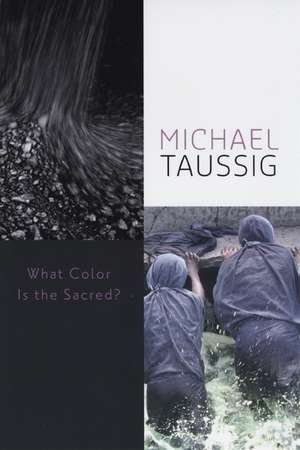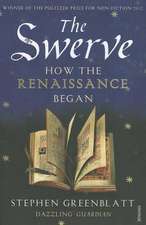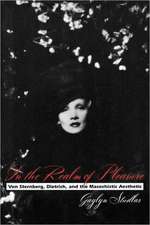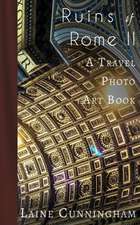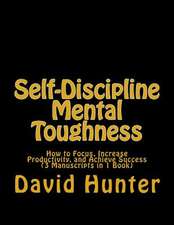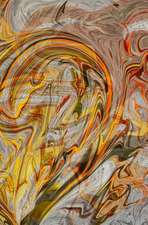What Color Is the Sacred?
Autor Michael Taussigen Limba Engleză Paperback – mai 2009
Over the past thirty years, visionary anthropologist Michael Taussig has crafted a highly distinctive body of work. Playful, enthralling, and whip-smart, his writing makes ingenious connections between ideas, thinkers, and things. An extended meditation on the mysteries of color and the fascination they provoke, What Color Is the Sacred? is the next step on Taussig’s remarkable intellectual path.
Following his interest in magic and surrealism, his earlier work on mimesis, and his recent discussion of heat, gold, and cocaine in My Cocaine Museum,this book uses color to explore further dimensions of what Taussig calls “the bodily unconscious” in an age of global warming. Drawing on classic ethnography as well as the work of Benjamin, Burroughs, and Proust, he takes up the notion that color invites the viewer into images and into the world. Yet, as Taussig makes clear, color has a history—a manifestly colonial history rooted in the West’s discomfort with color, especially bright color, and its associations with the so-called primitive. He begins by noting Goethe’s belief that Europeans are physically averse to vivid color while the uncivilized revel in it, which prompts Taussig to reconsider colonialism as a tension between chromophobes and chromophiliacs. And he ends with the strange story of coal, which, he argues, displaced colonial color by giving birth to synthetic colors, organic chemistry, and IG Farben, the giant chemical corporation behind the Third Reich.
Nietzsche once wrote, “So far, all that has given colour to existence still lacks a history.” With What Color Is the Sacred? Taussig has taken up that challenge with all the radiant intelligence and inspiration we’ve come to expect from him.
Following his interest in magic and surrealism, his earlier work on mimesis, and his recent discussion of heat, gold, and cocaine in My Cocaine Museum,this book uses color to explore further dimensions of what Taussig calls “the bodily unconscious” in an age of global warming. Drawing on classic ethnography as well as the work of Benjamin, Burroughs, and Proust, he takes up the notion that color invites the viewer into images and into the world. Yet, as Taussig makes clear, color has a history—a manifestly colonial history rooted in the West’s discomfort with color, especially bright color, and its associations with the so-called primitive. He begins by noting Goethe’s belief that Europeans are physically averse to vivid color while the uncivilized revel in it, which prompts Taussig to reconsider colonialism as a tension between chromophobes and chromophiliacs. And he ends with the strange story of coal, which, he argues, displaced colonial color by giving birth to synthetic colors, organic chemistry, and IG Farben, the giant chemical corporation behind the Third Reich.
Nietzsche once wrote, “So far, all that has given colour to existence still lacks a history.” With What Color Is the Sacred? Taussig has taken up that challenge with all the radiant intelligence and inspiration we’ve come to expect from him.
| Toate formatele și edițiile | Preț | Express |
|---|---|---|
| Paperback (1) | 255.65 lei 6-8 săpt. | |
| University of Chicago Press – mai 2009 | 255.65 lei 6-8 săpt. | |
| Hardback (1) | 583.58 lei 6-8 săpt. | |
| University of Chicago Press – mai 2009 | 583.58 lei 6-8 săpt. |
Preț: 255.65 lei
Nou
Puncte Express: 383
Preț estimativ în valută:
48.92€ • 51.07$ • 40.49£
48.92€ • 51.07$ • 40.49£
Carte tipărită la comandă
Livrare economică 04-18 aprilie
Preluare comenzi: 021 569.72.76
Specificații
ISBN-13: 9780226790060
ISBN-10: 0226790061
Pagini: 304
Ilustrații: 17 halftones
Dimensiuni: 152 x 229 x 33 mm
Greutate: 0.41 kg
Editura: University of Chicago Press
Colecția University of Chicago Press
ISBN-10: 0226790061
Pagini: 304
Ilustrații: 17 halftones
Dimensiuni: 152 x 229 x 33 mm
Greutate: 0.41 kg
Editura: University of Chicago Press
Colecția University of Chicago Press
Notă biografică
Michael Taussig is professor of anthropology at Columbia University and the author of several books, including Walter Benjamin’s Grave and My Cocaine Museum, both published by the University of Chicago Press.
Cuprins
List of Illustrations
Part One Into the Image
1. The Face of World History
2. Licensed Transgression
3. Where Stones Walk like Men
4. Color as Crime
5. Color Walks
6. The Diver
7. Could a Cat Be a Whale? 000
8. In the Time of Lapis Lazuli
9. Polymorphous Magical Substance
10. Plasma
11. A Beautiful Blue Substance Flows into Me
12. The Red Butterfly
Part Two Color in the Colony
13. Administration by Bluff
14. Walking through Fire
15. Sailing through Color
16. Body Paint
17. The Instrument of Ethnographic Observation
18. Color and Slavery
19. Redeeming Indigo
20. Opiation of the Visual Field
21. Sex Appeal of the Inorganic
Part Three Color in Proust
22. Crossover Men
23. Techniques of the Body: What We Falsely Call Life
24. An Hour is Not Merely an Hour
25. Cardiac Fatigue
26. What Is the Color of the Profane? 000
Part Four Color in Coal
27. Creature of the Lightless Depth
28. As Colors Pour from Tar
29. Colored by Weather
Acknowledgments
Notes
Bibliography
Index
Part One Into the Image
1. The Face of World History
2. Licensed Transgression
3. Where Stones Walk like Men
4. Color as Crime
5. Color Walks
6. The Diver
7. Could a Cat Be a Whale? 000
8. In the Time of Lapis Lazuli
9. Polymorphous Magical Substance
10. Plasma
11. A Beautiful Blue Substance Flows into Me
12. The Red Butterfly
Part Two Color in the Colony
13. Administration by Bluff
14. Walking through Fire
15. Sailing through Color
16. Body Paint
17. The Instrument of Ethnographic Observation
18. Color and Slavery
19. Redeeming Indigo
20. Opiation of the Visual Field
21. Sex Appeal of the Inorganic
Part Three Color in Proust
22. Crossover Men
23. Techniques of the Body: What We Falsely Call Life
24. An Hour is Not Merely an Hour
25. Cardiac Fatigue
26. What Is the Color of the Profane? 000
Part Four Color in Coal
27. Creature of the Lightless Depth
28. As Colors Pour from Tar
29. Colored by Weather
Acknowledgments
Notes
Bibliography
Index
Recenzii
“In the course of reflecting on shamanism and the Native cultures of the Americas, and the relationship of symbolism, drugs, and color, and introducing such interesting concepts as ‘preemptively apocalyptic knowledge’ and the bodily unconsciousness, the author offers no less than an ethnology of color. . . . It is also beautifully poetic, thoroughly rational, and an excellent read.”--Choice
"Michael Taussig has done it again. As with his previous books, Taussig has produced a unique account that takes readers on a journey—this time into the 'color of history'—that is electrifying, surprising, at times disconcerting and unsettling, but ultimately inspiring."
